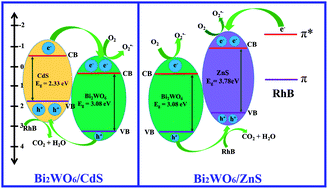The formation of type II heterostructures is proved to be an effective method to improve the photocatalytic performance of semiconductors. In this report, a surface functionalization method using 3-mercaptopropionic acid (MPA) as the surface functionalizing agent was adopted for the fabrication of Bi2WO6/MS (M = Cd and Zn) heterostructures. The composition and microstructures of the as-prepared heterostructures were characterized by X-ray diffraction (XRD), scanning electron microscopy (SEM), transmission electron microscopy (TEM), high-resolution TEM (HRTEM) and X-ray photoelectron spectroscopy (XPS). The as-prepared Bi2WO6/CdS and Bi2WO6/ZnS heterostructures exhibit enhanced photocatalytic activities for the degradation of Rhodamine B (Rh B) as compared to pure Bi2WO6, CdS, ZnS nanoparticles and Degussa P25. The enhanced photocatalytic activities of the as-prepared heterostructures may relate to the effective electron–hole separation during the photocatalytic process. A series of scavengers (benzoquinone for O2˙−, ammonium oxalate for h+, AgNO3 for e−, and t-BuOH for ˙OH) were employed to investigate the possible mechanism of the photocatalytic process. The results clearly indicate that the photogenerated holes are the main active species during the photocatalytic process.
